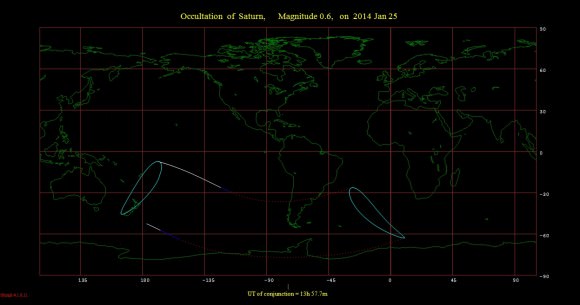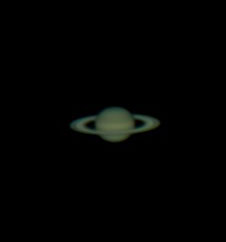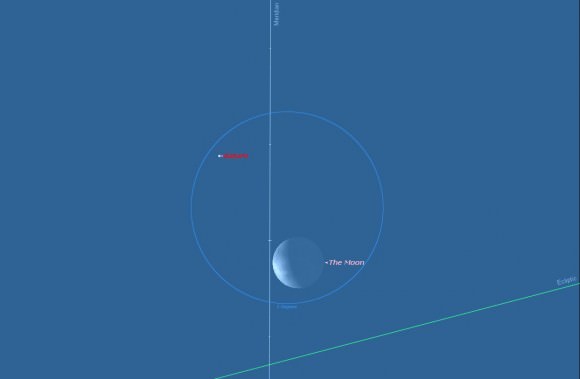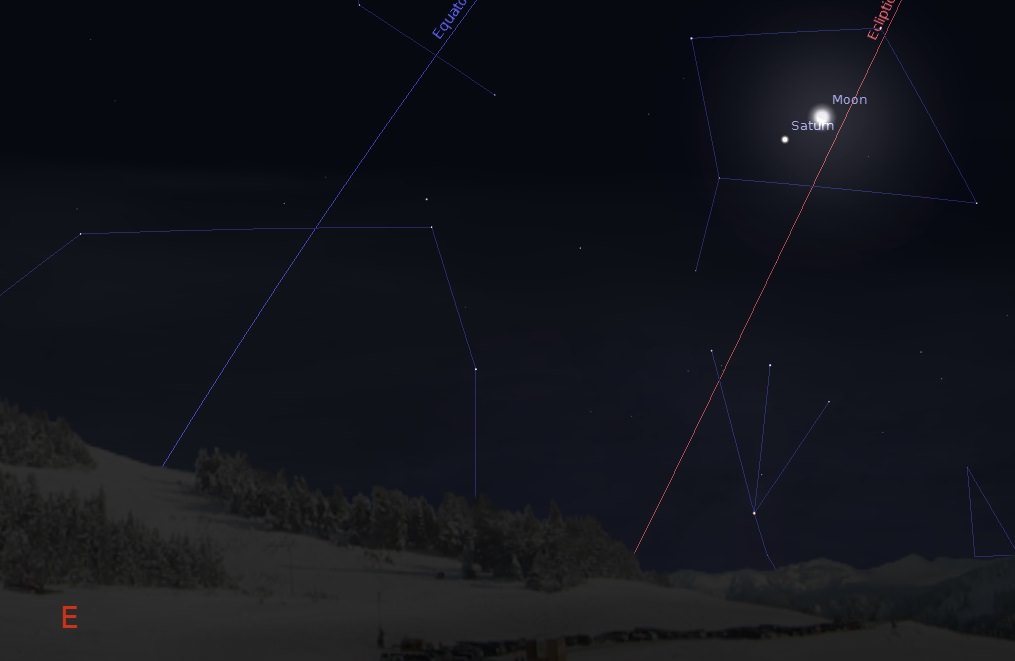Mark your calendars: the first in a series of interesting occultations of Saturn by the Moon for 2014 starts this weekend.
The year 2014 features 11 occultations of the planet Saturn by the Moon, and there are 23 total for 2014 of every planet except Neptune and Jupiter.
An occultation occurs when one foreground celestial object completely obscures another. Technically, a total solar eclipse is an occultation of the Sun by the Moon, although it’s never referred to as such. The term finds modern usage mainly for the blocking of stars and planets by the Moon. Very occasionally, an asteroid or planet can occult a distant star as well.
And yes, the modern astronomical term “occultation” traces its hoary roots back to the days when astronomy was intertwined with the pseudoscience of astrology. To this day, the term still makes some folks wonder if astronomers are secretly casting horoscopes. Trust us, you’re still on a solid astronomical footing to use the term “occultation.”
Unfortunately, the January 25th occultation of Saturn by the Moon will only grace part of Antarctica, southern Argentina and Chile, and the Falkland Islands post-sunrise. The rest of us still will see a very photogenic pass of Saturn near the waning crescent Moon on the morning of Saturday, January 25th. The Moon will pass just about a degree — two times its apparent width — south of Saturn for northern hemisphere observers.

Both the Moon and Saturn will reside in the astronomical constellation of Libra this weekend during closest passage. The pair will rise around 2 AM local. After their brief tryst, the Moon will head towards New on January 30th while Saturn will continue to rise successively earlier as its heads towards opposition and the start of evening Saturn observing season on May 10th, 2014.
January 2014 is also notable for having two New Moons, an occurrence informally known as a Black Moon. This occurs again this year in March, and February 2014 is devoid of a New Moon. February is the only month that can be “missing a Moon phase” as it’s the only one shorter the synodic period of 29.5 days, in which the Moon returns to like phase.

In the telescope, Saturn will present a +0.8 magnitude disk 16” across (38” with rings from tip-to-tip). Saturn’s rings are tipped open to our line of sight by about 22 degrees in 2014, and are widening towards a maximum of 27 degrees in 2016 through 2017. If you have an equatorial telescope with tracking capability, it may be possible this weekend to follow Saturn up into the daytime sky. Though Saturn isn’t quite bright enough to see in the daytime unaided, it might just be possible to spy using binoculars on the 25th using the nearby crescent Moon as a guide. Saturn is a tough daytime target to be sure, but it’s not impossible to acquire with a little skill and patience.
The current cycle of occultations of Saturn began on December 1st, 2013 and ends on November 22nd, 2014. The cycle will move progressively northward through the year.
The Moon and Saturn put on a repeat performance over almost the same exact location (this time in darkness) on April 17th, 2014, and the best event in the cycle for North America will be the August 31st daytime occultation of Saturn by the waxing crescent Moon.
Now for the wow factor of what you’re seeing. On Saturday morning, the Moon is just over 371,000 kilometres distant, or a little over a light second away. Saturn is over four thousand times more remote at just over 10.1 astronomical units (AUs) distant, which works out to 1.5 billion kilometres, or over 83 light minutes away. And although the Moon is over a 112 times larger in apparent diameter than Saturn as seen from the Earth, the globe of Saturn is actually over 34 times bigger.

And though we’ve been to the Moon lots since the dawn of the Space Age, only two spacecraft (Voyagers 1 and 2) have made brief flybys of the ringed world, and only one – Cassini – has orbited it. Note that China’s Chang’e-3 lander and rover are about to experience their second sunset this weekend as well from the lunar surface since landing on the Moon last month.
And although lots of planets get occulted by the Moon in 2014, no stars brighter than +1st magnitude lie in its path. In fact, the next cycle of bright star occultations by the Moon doesn’t resume until the Moon meets Aldebaran in January 29th, 2015.
There are, however, over a 100 lesser events involving the Moon occulting naked eye stars worldwide in 2014. Two such events occur this week as well, when the 48% illuminated Moon occults the +4.5th magnitude star Lambda Virginis for west-central South America on the morning of January 24th, and the occultation of the +2.8th magnitude star Alpha Librae (Zubenelgenubi) for central Asia on January 25th.
Don’t miss these celestial events, and be sure to send those pics in to Universe Today… there’s something for everyone happening in the sky this week worldwide!

